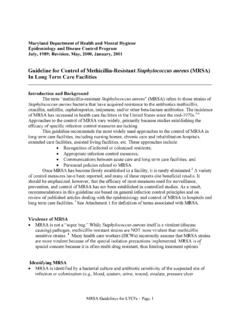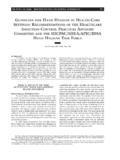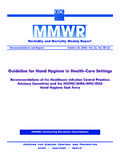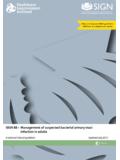Transcription of Core Concepts for Hand Hygiene: Clean Hands for Healthcare ...
1 Core Concepts for Hand Hygiene: Clean Hands for Healthcare Personnel 1. Presenter Russ Olmsted, MPH, CIC. Director, Infection Prevention & control Trinity Health, Livonia, MI. Contributions by Heather M. Gilmartin, NP, PhD, CIC. Denver VA Medical Center University of Colorado Laraine Washer, MD. University of Michigan Health System 2. Learning Objectives Outline the importance of effective hand hygiene for protection of Healthcare personnel and patients Describe proper hand hygiene techniques, including when various techniques should be used 3. Why is Hand Hygiene Important? The microbes that cause Healthcare -associated infections (HAIs) can be transmitted on the Hands of Healthcare personnel Hand hygiene is one of the MOST. important ways to prevent the spread of infection 1 out of every 25 patients has Too often Healthcare personnel do a Healthcare -associated not Clean their Hands infection In fact, missed opportunities for hand hygiene can be as high as 50%.
2 (Chassin MR, Jt Comm J Qual Patient Saf, 2015; Yanke E, Am J Infect control , 2015; Magill SS, N Engl J. Med, 2014). 4. Environmental Surfaces Can Look Clean but . Bacteria can survive for days on patient care equipment and other surfaces like bed rails, IV. pumps, etc. It is important to use hand hygiene after touching these surfaces and at exit, even if you only touched environmental surfaces Boyce JM, Am J Infect control , 2002; WHO Guidelines on Hand Hygiene in Health Care, WHO, 2009. 5. Hands Make Multidrug-Resistant Organisms (MDROs) and Other Microbes Mobile (Image from CDC, Vital Signs: MMWR, 2016). 6. When Should You Clean Your Hands ? 1. Before touching a patient 2. Before providing a Clean /aseptic procedure 3. After direct contact with body fluid 4. After touching a patient 5. After touching surfaces around a patient (Boyce JM, Am J Infect control , 2002; WHO Guidelines on Hand Hygiene in Health Care, WHO, 2009). 7. Partnering With Patients for Hand Hygiene Healthcare personnel should encourage patients, families and visitors to Clean their Hands Moments for patients to perform hand hygiene are: Before or after touching invasive devices or bandages IV, surgical site, feeding tube Before eating After using the restroom or handling a bedpan When entering or leaving their room (Sunkesula VC, Infect control Hospital Epidemiol, 2015; Image from Patients and Visitors.)
3 Clean Hands Count Campaign, CDC). 8. Empowering Patients to Speak Up Encourage patients to not be afraid to use their voice - that it's ok to ask their Healthcare provider questions, such as: I didn't see you Clean your Hands when you came in, would you mind cleaning them again before you examine me? . I'm worried about germs spreading in the hospital. Will you please Clean your Hands once more before you start my treatment? . 9. Hand Hygiene Methods Hand hygiene applies to use of either alcohol-based hand rub or the use of soap and water. Specific methods include: Alcohol-based hand rub Rubbing Hands with an alcohol-containing hand hygiene product Handwashing Washing Hands with plain soap and water Antiseptic hand wash Washing Hands with water and soap or other detergents containing an antiseptic agent Surgical hand hygiene/antisepsis Handwashing with antiseptic soap or using an alcohol-based hand rub before providing surgery (Boyce JM, Am J Infect control , 2002).
4 10. Which Method Kills Bacteria Better? (Boyce JM, Am J Infect control , 2002; WHO Guidelines on Hand Hygiene in Health Care, WHO, 2009). 11. What Are the Benefits of Alcohol-Based hand rubs? Requires less time More effective than washing with soap and water More accessible than sinks Reduces bacterial counts on Hands Improves skin condition (Boyce JM, Am J Infect control , 2002; WHO Guidelines on Hand Hygiene in Health Care, WHO, 2009). 12. A Picture of the Power of Hand Hygiene Panel A (left): Culture of Healthcare personnel's hand following ungloved abdominal exam of a patient colonized with methicillin-resistant S. aureus (MRSA). Panel B (right): Same personnel's hand after application of alcohol-based hand rub (Donskey CJ, N Engl J Med, 2009). 13. Choosing the Right Alcohol-Based Hand Rub and Using the Correct Technique Hand Rub (foam or gel). 1. Select an alcohol-based hand rub that is between 62% and 90% alcohol. 2. Apply to palm of one hand (the amount used depends on specific hand rub product).
5 3. Rub Hands together, covering all surfaces, focusing in particular on the fingertips, fingernails, and underneath fingernails, until dry (Image from Healthcare Providers. Clean Hands Count Campaign, CDC). 14. Hand Washing Technique Hand Washing (soap and water). 1. Wet Hands with water 2. Apply soap 3. Rub Hands together for at least 15 seconds, covering all surfaces, focusing on fingertips and underneath fingernails 4. Rinse under running water and dry with disposable towel 5. Use the towel to turn off the faucet 15. Myth Busters Around Hand Hygiene Hand hygiene method for patient with Clostridium difficile infection? Step 1. Put on gloves! Step 2. Consider RUB. IN (using hand rub) & WASH OUT. (soap). ( Healthcare Providers. Clean Hands Count Campaign, CDC Website ). 16. Myth Busters Around Hand Hygiene Where are the microbes?..Make sure you Clean under nails and fingertips ( Healthcare Providers. Clean Hands Count Campaign, CDC Website, ).
6 17. Myth Busters Around Hand Hygiene Use enough hand hygiene product Using gloves does not mean hand hygiene can be skipped! ( Healthcare Providers. Clean Hands Count Campaign, CDC Website, ). 18. References Boyce JM, Pittet D. Healthcare Infection control Practices Advisory Committee: HICPAC/SHEA/APIC/IDSA Hand Hygiene Task Force. Guideline for hand hygiene in health-care settings: Recommendations of the Healthcare Infection control Practices Advisory Committee and the HICPAC/SHEA/APIC/IDSA hand hygiene task force. Am J Infection control 2002; 30(8):S1-S46. Chassin MR, Mayer C, Nether K. Improving hand hygiene at eight hospitals in the United States by targeting specific causes of noncompliance. Jt Comm J Qual Patient Saf. 2015; 41(1):4-12. Clean Hands Count for Healthcare Providers. Centers for Disease control and Prevention. Donskey CJ, Eckstein BC. Images in clinical medicine. The Hands give it away. N Engl J Med. 2009; 360(3):e3.
7 FitzGerald G, Moore G, Wilson AP. Hand hygiene after touching a patient's surroundings: the opportunities most commonly missed. J Hosp Infect. 2013; 84(1):27-31. Guideline for Hand Hygiene in Healthcare Settings. Center for Disease control and Prevention. Magill SS, Edwards JR, Bamberg W, et al. Multistate point-prevalence survey of health care associated infections. N Engl J Med. 2014;. 370(13):1198-208. Patients and Visitors. Clean Hands Count. Centers for Disease control and Prevention, CDC. Available at Pittet D, Allegranzi B, Sax H, et al. Evidence-based model for hand transmission during patient care and the role of improved practices. Lancet Infect Dis. 2006; 6(10):641-52. Sunkesula VCK, Knighton S, Zabarsky TF, et al. Four Moments for Patient Hand Hygiene: A Patient-Centered, Provider-Facilitated Model to Improve Patient Hand Hygiene. Infect. control Hosp. Epidemiol. 2015; 36:986 989. Vital Signs: Preventing Antibiotic-Resistant Infections in Hospitals United States.
8 Centers for Disease control and Prevention. MMWR. 2016;65:235-41. WHO Guidelines on Hand Hygiene in Health Care. World Health Organization (WHO). Published 2009. Available at Yanke E, Zellmer C, Van Hoof S, et al. Understanding the current state of infection prevention to prevent Clostridium difficile infection: a human factors and systems engineering approach. Am J Infect control . 2015; 43(3):241-7. 19. THANK YOU! 20. SPEAKER NOTES. 21. Speaker Notes: Slide 1. Welcome to this module titled Core Concepts for Hand Hygiene: Clean Hands for Healthcare Personnel. We will review the critical role of hand hygiene as a foundation for preventing Healthcare -associated infections. Hand hygiene is one of the most important interventions to prevent the transmission of microorganisms on the Hands of Healthcare personnel. Proper hand hygiene removes those microbes and prevents exposure to patients during care delivery. Let's learn more about this foundation for preventing infection and keeping patients safe.
9 22. Speaker Notes: Slide 2. The content for this module was developed by Russ Olmsted, Director of Infection Prevention and control at Trinity Health, in Livonia, Michigan and informed by a multidisciplinary team of physicians, nurses and infection preventionists dedicated to improving patient safety and infection prevention efforts. In particular, we would like to thank and acknowledge doctors Heather Gilmartin and Laraine Washer and the STRIVE national project team for their contributions and review of this module. 23. Speaker Notes: Slide 3. This module will outline the importance for Healthcare personnel to Clean their Hands to protect their patients and themselves. It will also review methods for hand hygiene. Hand hygiene includes washing with soap and water, or using alcohol-based hand rub some use the term hand sanitizer in place of hand rub. We'll also learn when Healthcare personnel should Clean their Hands specifically, the moments for hand hygiene.
10 24. Speaker Notes: Slide 4. So why is hand hygiene so important for providing safe care to patients? The reason is that many Healthcare -associated infections, or HAIs, can be transmitted on the Hands of Healthcare personnel. One out of every 25 patients has a Healthcare -associated infection and of these one out of every nine will die from the infection. Hand hygiene, therefore, is one of the most important steps Healthcare personnel can use to keep patients safe. However, despite this awareness by personnel, observers of adherence to hand hygiene by Healthcare personnel find it is missed in 50 percent of opportunities. 25. Speaker Notes: Slide 4 Continued Importantly, this is true even when caring for patients on contact precautions for Clostridioides difficile infection (CDI). One study found that the frequency of cleaning Hands by personnel when leaving the patient's room used for contact precautions for Clostridioides difficile infection ranged between 23 to 55 percent.













